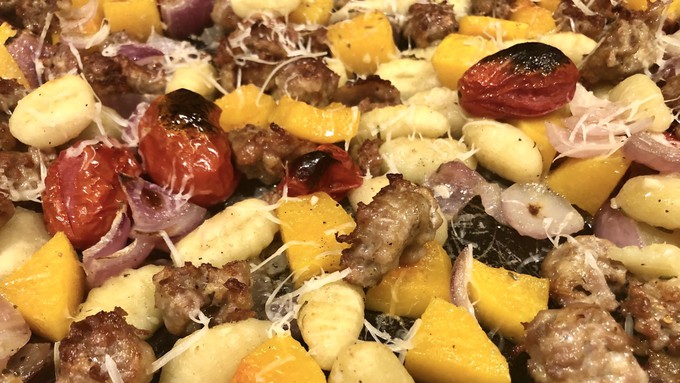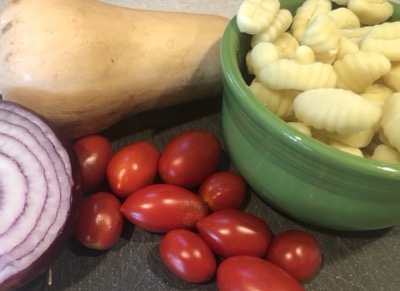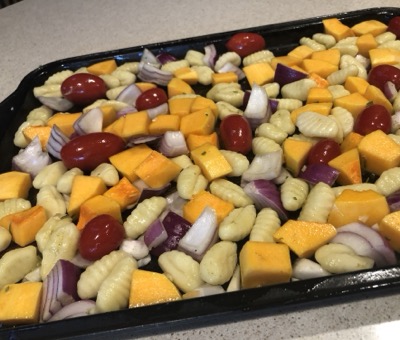
Recipe: Butternut squash plus tomatoes plus gnocchi for the win

Potato gnocchi roasted with vegetables and sausage makes an easy one-pan meal. Kathy Morrison
So it’s cool enough to cook dinner in the oven, but still nice enough that I don’t want to spend hours in the kitchen. Garden things to do outside, you know.
The solution: A sheet-pan meal, in which all the ingredients roast together in the oven.
This dish is a riff on a recipe from thekitchn.com. Substitutions are easy: I had Juliet tomatoes but no mushrooms, so into the pan they went. Broccoli cut small would work or green beans or whatever, but don’t forget to include onions.
Gnocchi cooked in the oven is far superior in flavor and texture to boiled gnocchi. It puffs up and gets just a bit crispy – delightful.
Sheet pan gnocchi with vegetables and sausage
Serves 4
Ingredients:

1 small butternut squash, peeled, deseeded and cut into chunks
1 small or ½ large red onion, cut into 1-inch chunks
8 ounces mushrooms, quartered, or 8-12 ounces grape or cherry tomatoes
1 package (1 pound or more) shelf-stable potato gnocchi
1 to 2 tablespoons fresh rosemary, chopped
8 to 16 ounces uncooked hot or sweet Italian sausage, in casings or bulk
2 tablespoons olive oil
1/2 teaspoon kosher salt, or to taste
Freshly ground black pepper, to taste
Grated Parmesan cheese, for serving
Instructions:
Arrange two oven racks to split the oven into thirds. Preheat oven to 425 degrees.
On a large rimmed baking pan, combine the butternut chunks, the onion and the mushrooms or tomatoes (or use both!). Sprinkle the rosemary over the vegetables, and add the gnocchi to the pan. Drizzle the olive oil over the pan, then sprinkle with about ½ teaspoon of salt and grinding of black pepper. Toss to coat.
Remove the sausage from its casings and drop bite-size chunks of it all over the vegetables and gnocchi.

Place the sheet pan on the lower rack of the oven. Roast for about 25 minutes, stirring after about 15 minutes. The sausage should be cooked through, the gnocchi plumped and the butternut chunks tender.
Move the sheet pan to the upper rack and broil on High until the gnocchi are lightly brown and crisp. This happens quickly, about 3 minutes, so don’t walk away.
Serve in large bowls and topped with grated Parmesan, if desired. A salad and a glass of zinfandel are perfect accompaniments.
Comments
0 comments have been posted.Sacramento Digs Gardening to your inbox.
Food in My Back Yard Series
May 6: Maintain soil moisture with mulch for garden success
April 29: What's (already) wrong with my tomato plants?
April 22: Should you stock up on fertilizer? (Yes!)
April 15: Grow culinary herbs in containers
April 8: When to plant summer vegetables
April 1: Don't be fooled by these garden myths
March 25: Fertilizer tips: How to 'feed' your vegetables for healthy growth
March 18: Time to give vegetable seedlings some more space
March 11: Ways to win the fight against weeds
March 4: Potatoes from the garden
Feb. 25: Plant a fruit tree now -- for later
Feb. 18: How to squeeze more food into less space
Feb. 11: When to plant? Consider staggering your transplants
Feb. 4: Starting in seed starting
Sites We Like
Garden Checklist for week of May 11
Make the most of the lower temperatures early in the week. We’ll be back in the 80s by Thursday.
* Plant, plant, plant! It’s prime planting season in the Sacramento area. Time to set out those tomato transplants along with peppers and eggplants. Pinch off any flowers on new transplants to make them concentrate on establishing roots instead of setting premature fruit.
* Direct-seed melons, cucumbers, summer squash, corn, radishes, pumpkins and annual herbs such as basil.
* Harvest cabbage, lettuce, peas and green onions.
* In the flower garden, direct-seed sunflowers, cosmos, salvia, zinnias, marigolds, celosia and asters. (You also can transplant seedlings for many of the same flowers.)
* Plant dahlia tubers.
* Transplant petunias, marigolds and perennial flowers such as astilbe, columbine, coneflowers, coreopsis, dahlias, rudbeckia and verbena.
* Keep an eye out for slugs, snails, earwigs and aphids that want to dine on tender new growth.
* Feed summer bloomers with a balanced fertilizer.
* For continued bloom, cut off spent flowers on roses as well as other flowering plants.
* Add mulch to the garden to maintain moisture. Mulch also cuts down on weeds. But don’t let it mound around the stems or trunks of trees or shrubs. Leave about a 6-inch-to-1-foot circle to avoid crown rot or other problems.
* Remember to weed! Pull those nasties before they set seed.
* Water early in the day and keep seedlings evenly moist.